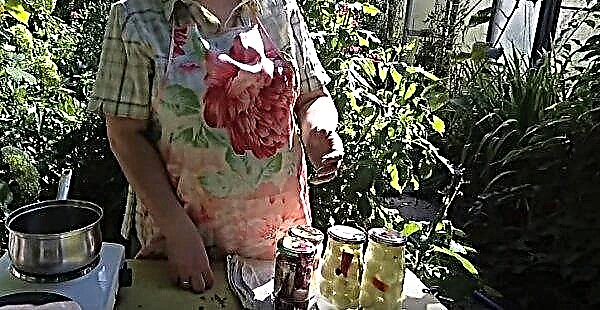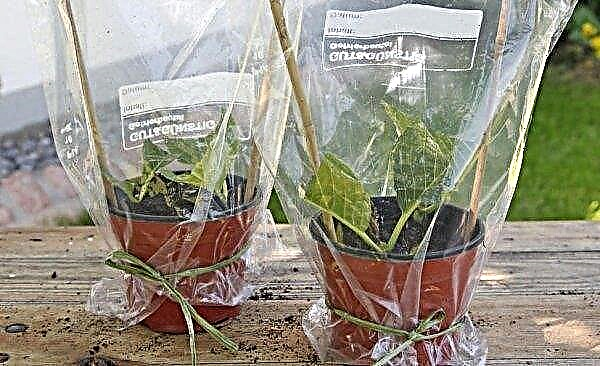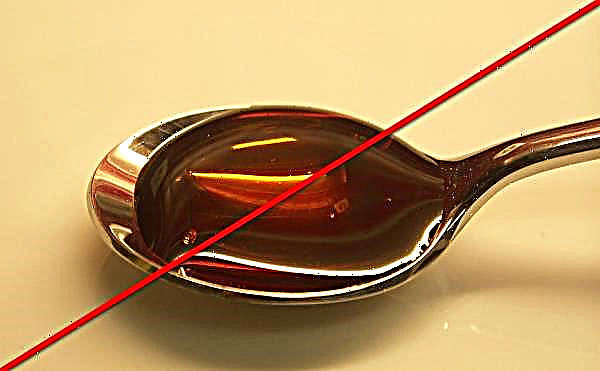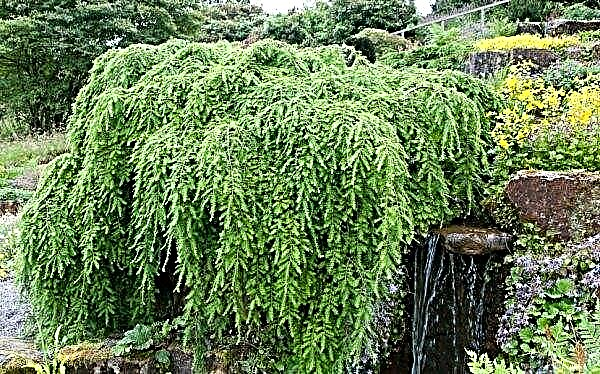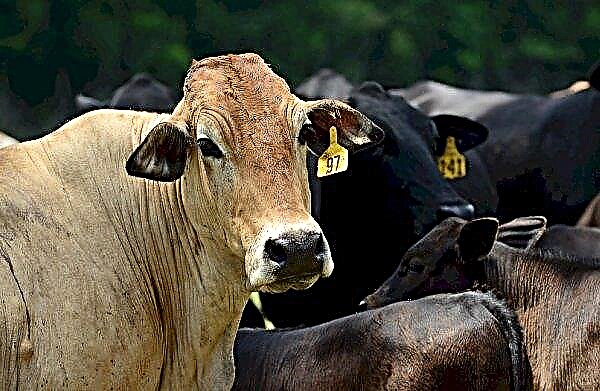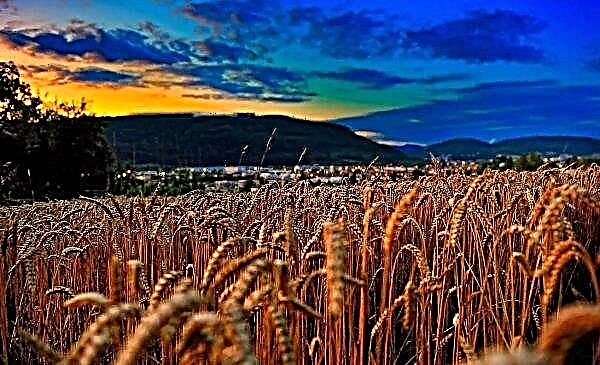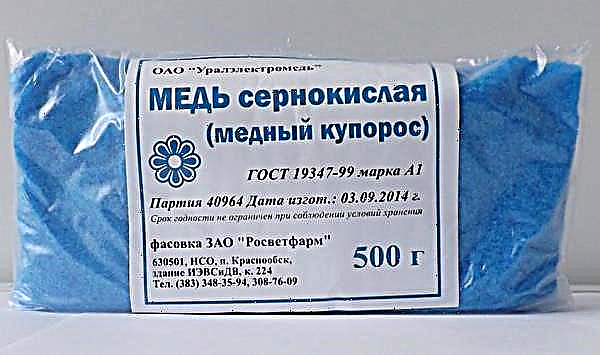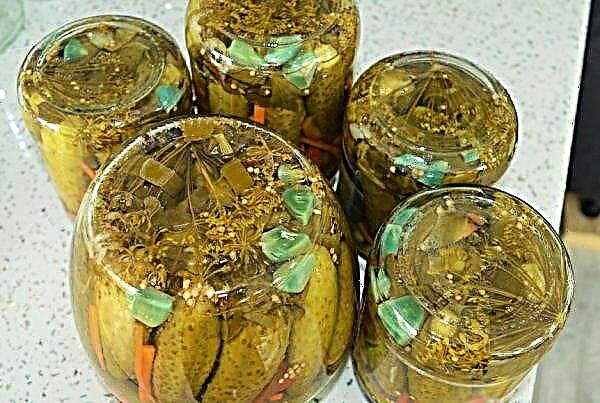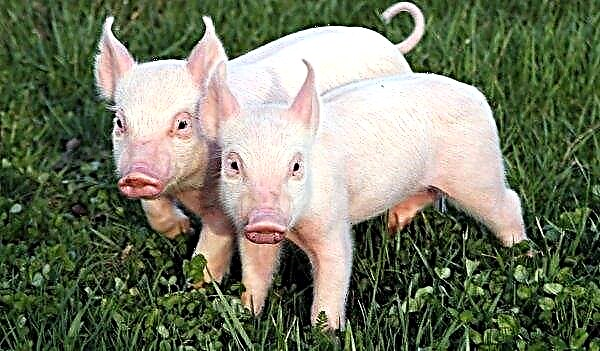Red onion varieties are appreciated for their milder taste and the presence of the antioxidant anthocyanin, which stains their scales with a reddish color. This variety is preferred to be used for salads, since during heat treatment it acquires a somewhat grayish tint. Find out what Carmen red onion variety is, what its benefits and harms are, how to grow and store it.
Description and characteristics of the variety
This mid-season variety of red onions was bred by Dutch breeders. He forms aligned bulbs of medium density and a rounded flat shape. They have darkish red-violet outer scales; inside they are white-violet, juicy, with a mild sweet taste. Their weight usually falls within the range of 50–80 g. In addition to the Carmen variety, there is a mid-season Carmen MS variety, differing only in that its bulbs have white veins. Green feathers from bulbs grow to 30 cm.
Did you know? Onions are the most popular plant crop to eat. It is grown in more than 175 countries. Plots with its landings outperform even wheat crops.
The yield of the variety is about 2.5 kg per 1 m². It can be grown in all regions, but the most acceptable are Central, Middle Volga and Central Black Earth. Depending on the climate, the growing place for ripening requires from 65 to 90-100 days from planting. Usually, this onion is grown as a two-year crop, but when using the seedling method, it can be grown in one season. Harvested in favorable conditions can be stored up to 8 months.
Properties of onions Carmen
Red onions are primarily valued for their higher antioxidant content.
Benefit
- The use of Carmen red onion is useful as follows:
- Strengthens the immune system. It contains a lot of vitamin C and volatile, which kill viruses. It has anti-inflammatory and expectorant effects. This makes it useful during seasonal outbreaks.
- Prevention of cardiovascular disease. Consumption of this product helps lower cholesterol and strengthens blood vessels, and potassium removes excess fluid. This helps reduce blood pressure and prevents many heart problems.
- It activates the digestive tract, stimulates appetite and has a beneficial effect on the pancreas.
- Improves metabolic processes and promotes weight loss.
- It contains antioxidants that prevent cancer and slow down aging.
- It has anthelmintic properties.
- Reduces the likelihood of diabetes.
- It can be used in home cosmetics. Hair maxi with this vegetable helps strengthen the hair follicles. It has a whitening effect on the skin and prevents the appearance of wrinkles.
- Green onion feathers are an excellent multivitamin product - especially in the spring, when the human body lacks vitamins. Therefore, bulbs are often germinated on the windowsill.
Harm and contraindications
Red onion is certainly good for health, but in some cases can harm it.
Important! Children from 8 months old can be given a boiled product. Raw onions can be introduced into the baby’s diet no earlier than three years of age and only in the absence of digestive problems.
- Contraindications to its consumption are as follows:
- allergy to this product or individual intolerance;
- flatulence;
- gastrointestinal diseases (gastritis, ulcers, colitis), especially during exacerbation;
- pancreatitis
- exacerbation of hepatic and renal diseases.
With these diseases, it is better to consume a vegetable that has undergone heat treatment, since it is not as irritating to the mucous membranes as raw. During exacerbations of the gastrointestinal tract, pancreatitis, and with allergic reactions, it is necessary to exclude it. When breastfeeding, it is better to consume a boiled product.
How to grow at home in the winter
This onion is often preferred to be grown in winter crops, which allows you to get earlier crops.
Optimum seeding time
For winter crops, the sowing plants are planted a month before the frosty weather is established, and the nigella (i.e. seeds for sowing) is planted immediately before frost. Often seeds are sown in the snow. In this case, it is very important to choose the right time in order to exclude the return of heat, because the bulbs and seeds can germinate, and die when frosts occur. Usually these dates fall at the end of autumn, but you need to be guided by the local climatic conditions and weather forecasts.
The sevka must take root before frost, but do not germinate. It is usually planted with small night frosts (up to -4 ° C), when the air temperature during the day is at 0 ... + 5 ° C.
Growing conditions
The variety under consideration requires good lighting, so on the site you need to find a place devoid of shade. Stagnation of water in this place is unacceptable, but close groundwater is allowed. Good predecessors are cucumbers, cabbage, tomatoes and legumes. Repeated plantings of Carmen onions on the same beds, as well as after garlic and herbs, are not recommended. Re-landing is best done no earlier than after 3-4 years. Onions begin to vegetate at a temperature of + 10 ° C, but the range + 20 ... + 25 ° C is considered the best temperature regime. Its seedlings can tolerate a drop in temperature to -4 ° C. The crop is responsive to watering in the first 2 months, and then, for better ripening, the bulbs need soil with low humidity.
Onions begin to vegetate at a temperature of + 10 ° C, but the range + 20 ... + 25 ° C is considered the best temperature regime. Its seedlings can tolerate a drop in temperature to -4 ° C. The crop is responsive to watering in the first 2 months, and then, for better ripening, the bulbs need soil with low humidity.
Soil and fertilizer
Onions prefer loose nutrient soils with a neutral or slightly alkaline reaction (pH 6-7). Usually it is black earth, loam or sandy loam. Coarse sand and organics are introduced into clay heavy soils for loosening. Sour soils lime, because the culture does not tolerate them.
During the autumn digging, organic matter (humus or rotted manure) and mineral fertilizers are added. On 1 m², 2-3 kg of organic fertilizer, 30 g of superphosphate, 10 g of ammonium nitrate and 15 g of potassium sulfate are applied. Immediately before planting, it is recommended that ash be added to the ground at the rate of 10 g per 1 m².
Important! The introduction of fresh manure under onions is unacceptable - this can cause various diseases.
Cultivation methods
To grow a variety of onions Carmen in winter crops, you can seed or sowing.
Seed cultivation
Before sowing, the seed material is soaked for 24 hours in a solution of potassium permanganate (0.1 g per 1 liter). Then it is dried and sown in the ground. When sowing on beds, they make shallow (2-3 cm) narrow furrows at a distance of 20 cm from each other and distribute seeds in them at the rate of 0.5 g per 1 m of furrow. It is recommended to protect crops with mulch (peat, sawdust) or fir branches, which must be removed on time in the spring.
When sowing on beds, they make shallow (2-3 cm) narrow furrows at a distance of 20 cm from each other and distribute seeds in them at the rate of 0.5 g per 1 m of furrow. It is recommended to protect crops with mulch (peat, sawdust) or fir branches, which must be removed on time in the spring.
Planting Sevka
Before planting, they prepare the beds and onion sets. It is sorted and dried in a warm place. Smaller bulbs will go to the turnip, and larger ones to get green feathers. Before planting, the seeds can be disinfected for 5 minutes in a solution of copper sulfate (1 teaspoon in 2 liters of warm water). Then the bulbs are dried and planted. To do this, make furrows with a depth of 5 cm with a distance between them of 20 cm.
Bulbs are placed in them at a distance of 5-7 cm from each other and covered with earth. Winter plantings are not watered, but if dry weather is already a decade, then you should carry out one watering. After the onset of stable frosts, the planting should be covered with dry leaves, and put spruce branches or branches on top. In winter, it is necessary to throw snow on such beds.
Variety Care Features
In the spring, mulch and cover are removed from the winter plantings of Carmen onions. Subsequent care has its own characteristics.
Watering and feeding
Watering onions is largely dependent on the weather. It should be noted that onions do not like overflows. Watering should be carried out 1-2 times every 14 days with water heated to + 20 ... + 30 ° C. In dry weather, you need to water it once every 7 days. After planting the onion set, about 10 l of water goes per 1 m², then the amount of water for irrigation is reduced. Watering is carried out between rows without strong pressure so as not to damage the plants.
To get a good harvest, it is enough 3 times for the entire growing season to add top dressing:
- 14 days after the seedling is planted, nitrogen-containing fertilizers are used - nitrophosphate, urea.
- After another 14 days, phosphorus and potassium fertilizers are added.
- After a crescent (14-15 days), phosphorus and potassium fertilizers are reused.

Soil loosening
After moistening the soil, it should be loosened. Usually it is carried out the day after watering. The earth is loosened between rows, shallow, trying not to damage the bulbs.
Weeding
During loosening of the soil, weed removal should be carried out, which draws moisture and nutrients from the soil. Moreover, weeds hold moisture and can provoke the process of rotting of the bulbs due to the appearance of fungal diseases.
Pest and Disease Control
Onions Carmen may be susceptible to the invasion of the following pests:
- onion secretive hunter;
- onion flies and moths;
- nematodes;
- ticks.
To prevent the occurrence of such pests and diseases, it is recommended to carry out preventive spraying with fungicides such as Fitosporin-M, Alirin, Gamair, Bordeaux liquid or a 5% solution of copper chloroxide. If yellowing or curling of the leaves is detected, as well as the drying of the plant, it is necessary to remove such bulbs to prevent infection of neighboring specimens.
If yellowing or curling of the leaves is detected, as well as the drying of the plant, it is necessary to remove such bulbs to prevent infection of neighboring specimens.
Important! After using chemical preparations from pests, onions should not be taken for consumption for 2-3 days.
Cleaning and storage
Onions Carmen harvested in late summer or early September. The weather should be chosen dry and clear, without rain. If this vegetable grows on light soils, then the onion heads are simply pulled out for the tops; on heavy soils turnip gently pick up a shovel or pitchfork. The ground from the fruit is gently shaken off with your hands. Do not tap the bulb with one head on the other - this can cause damage.
Harvested crops are moved to the attic or under a canopy in the air to allow it to dry well; while the fruits should be turned from time to time. It takes 7-10 days. Then you should inspect the crop and discard copies unsuitable for storage. Turnips with a somewhat wide neck should be used first, and the remaining intact instances are left for storage. After drying the vegetables, the neck of the turnip is cut off, leaving only about 3-5 cm. The tops can also be braided with twine and hung in a barn. The roots are cut with a knife. Vegetables with cut tops are placed in boxes made of plastic or wood. Then they are taken to a storage place - a cool, dark and fairly ventilated room.
After drying the vegetables, the neck of the turnip is cut off, leaving only about 3-5 cm. The tops can also be braided with twine and hung in a barn. The roots are cut with a knife. Vegetables with cut tops are placed in boxes made of plastic or wood. Then they are taken to a storage place - a cool, dark and fairly ventilated room.
Storage conditions:
- humidity not more than 70%;
- temperature in the range from + 20 ° С to 0 ° С.
Useful Tips
To get a good Carmen crop, professional gardeners give the following tips:
- When choosing a site, observe crop rotation.
- Be sure to disinfect planting material before planting. Seeds (several pieces) are recommended to be checked by soaking them before hatching.
- Remove all vegetation residues in the fall and dig with fertilizers.
- Inspect for the presence of diseases and pests for the timely adoption of measures to eliminate them.
- Plant marigolds near onions to protect them from pests.
- The use of ash as a fertilizer reduces the acidity of the soil and protects the plant from disease.
 So, Carmen red onion variety is healthy and has a mild taste, is well stored, is used mainly in its raw form.
So, Carmen red onion variety is healthy and has a mild taste, is well stored, is used mainly in its raw form.Did you know? Bow calls withtenacity due to the content of certain amino acids, which upon destruction of the cells during cutting become a volatile compound. When it gets on the mucous membrane of the eye, as a result of this interaction, sulfuric acid is obtained, which irritates the eyes.
It can be planted in the winter for early production. Particularly attractive is the ability to adapt to different climates.

